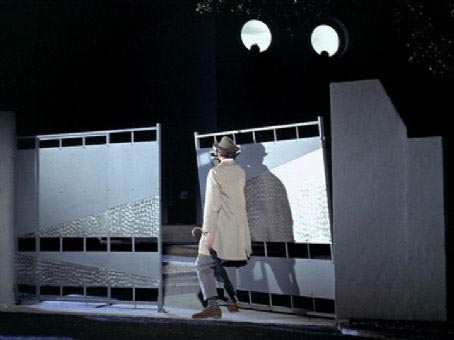From
the very opening of the film it is apparent that Jacques Tati’s Mon Oncle is not going to follow the
standards of comedic filmmaking. The comedy is set in a world of heightened
reality, where one side of the town is an idyllic picture of rural France, and
the other is the most “modern” neighborhood around, featuring architectural
novelties and everything plastic. As the antics play out in a relaxed pace, the
bounds of standard narration don’t impede on the pleasure of the
story—character focus is fluid, and goals are just passing fancies. Through
sound and dialogue, unique cinematography, and manipulation of setting, the
experimentation in the film Mon Oncle reflects
its theme that natural experimentation and mischief can bring family closer
together.
The
sounds in Mon Oncle indicate the
modern versus the organic, or in other words the bad and the good, and cue the
audience to appreciate rural mischief of Hulot’s world over the rigid order of
Arpel’s. Only when the scene is with the Arpels and their modern world are
there obviously contrived sound effects featured, such as the fountain, the
doorbell, and the breathing sounds in the factory. In Hulot’s neighborhood
there is music and the organic sounds of birds tweeting and children
laughing—as well as dialogue, which is treated as just another sound. The film uses
this vague sound to draw attention to the mischief that is developing Hulot and
Gerard’s relationship.
Additionally,
the other sounds of the film consistently compete with the dialogue and often
have more to do with the story at hand. For example, the obnoxious sound of
water trickling from the fish fountain indicates the Arpel family’s pride and
control. During the dinner party Hulot manages to break the fountain, and the
trickling is even more chaotic and distracting than normal. This reflects the
fact that Hulot is bringing in the organic mess of his world into the Arpel’s
home—though in the last scene of the film it’s clear that this chaos will
create a relationship between father and son. On the reverse, when Monsieur
Arpel brings his fancy new car into Hulot’s neighborhood, the music that has
always accompanied that area is, like the fountain, halted and restarted again
and again as Arpel tries to parallel park his car between two carriages. The
car is unwelcome in this world of fun, and the obsessively methodical way Arpel
is parking is interrupting the natural pleasure of life.
Mon Oncle is told visually, and
consequently the cinematography does its part in non-traditionally communicating
comedy. The film does very little to methodically draw audience attention to
certain elements, but rather lets the audience play with their own attention
like Gerard playing with the village children. First, most of the shots are
extremely wide, and from interesting angles. Rather than shooting things for
their aesthetic appeal, Tati angles the camera in order to capture the most
action possible for the longest amount of time possible. In one long shot the
audience can see the entirety of Hulot’s apartment building. The shot lasts as
long as it takes for Hulot to climb up the chaotically designed building to his
own room. The film lets the audience follow their own interests in the scene.
Consequently, the film plays out more like a comic strip—a frame of visuals
plus a few sound effects—rather than a narrative film.
Lastly,
Mon Oncle experiments with its
environment, and combines tdiegetic and non-diegetic elements to create an
atmosphere of mischief and fun. One notable moment is when Hulot is trying to
finish trimming the bush, and wakes up the Arpels. The Arpel’s heads are
silhouetted in their ultra-modern windows, making is appear as if the house has
eyes and their heads are the pupils. They move in unison and consequently the
house “looks around.” Hulot’s interaction with the environment is the most
comedic element, such as when he is trying to use the kitchen. As mentioned
before, the opening credits are all written on elements of the
environment—signs and chalk drawings. This combination of diegetic and
non-diegetic breaks the rules of traditional storytelling and reminds the
audience that they are watching a constructed reality.
In
the end, when Gerard and his father enjoy the results of a prank, Gerard grabs
his father’s hand in a moment of affection. All of these moments that
experiment with film form lead the audience to understand that this humor and
clumsiness are what brought the family together.
